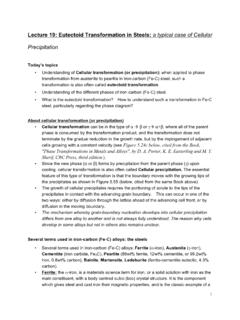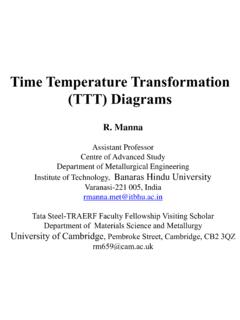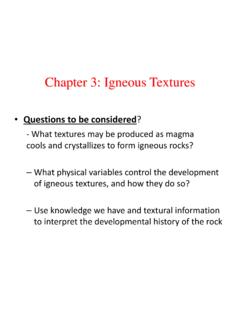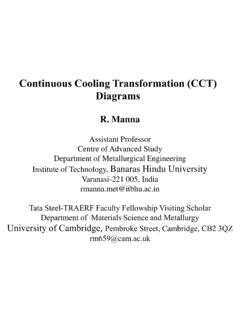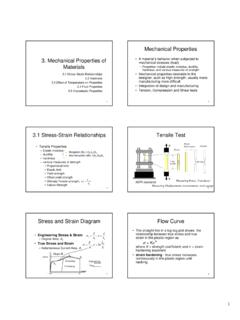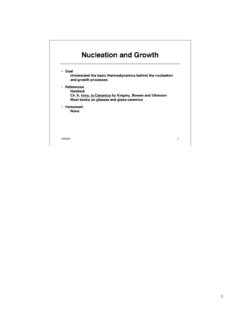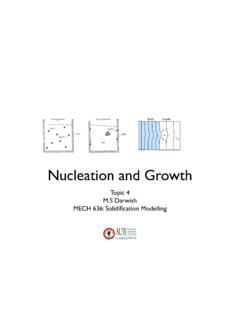Transcription of Lecture 10: Homogeneous Nucleation
1 1 Lecture 10: Homogeneous Nucleation Today s topics What is Nucleation ? What implied in real practice of materials processing, particularly phase transformation? General comparison between Homogeneous and heterogeneous Nucleation . Critical particle (or nucleus) size (r*) for a Homogeneous Nucleation from liquid ( , solidification of metals). How to derive and understand the critical size in terms of both thermodynamics and kinetics of Nucleation . About Nucleation Nucleation : localized formation of a distinct thermodynamic phase.
2 Nucleation an occur in a gas, liquid or solid phase. Some examples of phases that may form via Nucleation include: 1) in gas: Creation of liquid droplets in saturated vapor; 2) in liquid: fromation of gaseous bubbles, crystals ( , ice formation from water), or glassy regions; 3) in solid: Nucleation of crystalline, amorphous, and even vacancy clusters in solid materials. Such solid state Nucleation is important, for example, to the semiconductor industry. Most Nucleation processes are physical, rather than chemical.
3 Nucleation normally occurs at Nucleation sites on surfaces contacting the liquid or vapor. Suspended particles or minute bubbles also provide Nucleation sites. This is called heterogeneous Nucleation ( Lecture 12). Nucleation without preferential Nucleation sites is Homogeneous Nucleation ( Lecture 10-11). Homogeneous Nucleation occurs spontaneously and randomly, but it requires superheating or supercooling of the medium. Compared to the heterogeneous Nucleation (which starts at Nucleation sites on surfaces), Homogeneous Nucleation occurs with much more difficulty in the interior of a uniform substance.
4 The creation of a nucleus implies the formation of an interface at the boundaries of a new phase. Liquids cooled below the maximum heterogeneous Nucleation temperature (melting temperature), but which are above the Homogeneous Nucleation temperature (pure substance freezing temperature) are called supercooled. An example of supercooling: Pure water freezes at 42 C rather than at its freezing temperature of 0 C. So, if cooled slowly below the freezing point, pure water may remain liquid (supercooled) as you see in this movie: ~lzang/ The crystallization into ice may be facilitated by adding some Nucleation seeds : small ice particles, or simply by shaking --- enjoy the movie clip.
5 2 For a particle of radius r of a pure element (see Lecture 8, 9): P = r 2, surface energy (r) = ( ) + rVM 2= 0 + rVM 2 Consider liquid metal cooled through its melting point, TM, into the stability regime of solid phase. The process of solidification must occur by forming a small particle of solid phase, s(r) = s( ) + rVM 2= s0 + rVM 2 where s0 the chemical potential of the solid phase corresponding to a flat surface bulk material.
6 At TM, solid (bulk) is in equilibrium with the liquid: s0 = l0, where l0 is the chemical potential of the liquid molar Gibbs free energy. For T<TM, s0 < l0, solidification should occur --- thermodynamically favorable for such bulk-phase solidification (r ). However, s(r) > s0, not necessarily for s(r) > l0; indeed, when r is very small, it is possible for s (r) > l0. This implies that: even at a T<TM, a very small particle of solid can still be thermodynamically unstable against the liquid phase --- it might dissolve back to the liquid.
7 As shown in the diagram, at a T<TM, there is a critical size (radius, r*) for the nucleus (or particle): for particles larger than the r*, s(r) l0, continuous Nucleation into larger particle and eventually transformed into a bulk phase of solid will becomes favorable; in comparison, for particles smaller than the r*, s(r) > l0, continuous Nucleation becomes unfavorable, and dissolving back to liquid becomes more favorable.
8 At T, particle of the critical size (r*) in equilibrium with the liquid, s (r*) = l0 , then we have s (r*) = s0 + *2rVM = l0 Once a critical size is achieved, if particle grows, s ( r>r*)< l0, solidification can proceed (as pointed by the (r*, critical radius at T) Supercooling (or undercooling), for nickel, it is about 250 K supercooled under the melting point 1453 oC 3 red arrow in the diagram). then r* = 002lsMV = MlsV002 = VG 2 VM: molar volume of the solid; VG = Gibbs free energy change for solidification (per unit volume, neglecting the difference in molar volume of the solid and liquid) --- such assumption is based on the fact that at TM liquid has a volume only 2-4% larger than the solid.
9 An alternative way to derive r*: As a solid particle of radius r forms from the liquid, the change of Gibbs free energy is G(r) = MlsVr00334 + 4пr2 Or G(r) = VGr 334 + 4пr2 --- for a particle formation, the free energy change G(r) is balanced by the two competitive factors, the volume free energy and interfacial energy due to formation of solid phase, just as depicted in the diagram below. For T<TM, 00ls <0, hence VG <0. As r increases, initially for small r, r2>r3, so G(r)>0; for large r, r2<r3, G(r) <0.
10 Thus, G(r) must go through a maximum. r0 (r) (r) 4 At the maximum, rGrdrrGdVr840)(2*+ == Then, r* = VG 2 Then, G* = G(r*) =324*4*3 VrG r + =232233316)4(4)8(34 VVVVGGGGr = + G* is Nucleation barrier for solidification. Beyond r*, G(r) decrease with increasing r, and at r0, G(r) = 0 04342030=+ rGrV Then we have, r0 = VG 3 When a particle size grows to r0, the Nucleation barrier decreases to zero. However, G(r0) is not a minimum, the Nucleation is presumed to continue as the G(r) will become < 0 (thermodynamically favorable) after passing r0.





